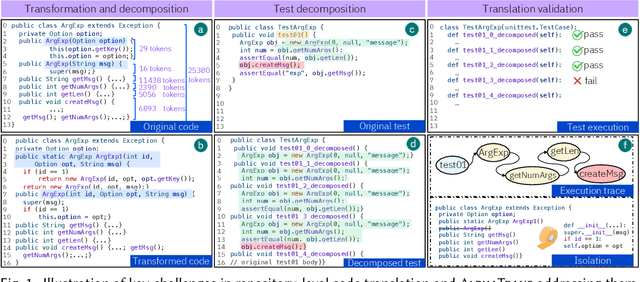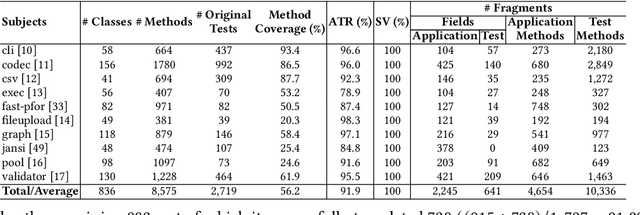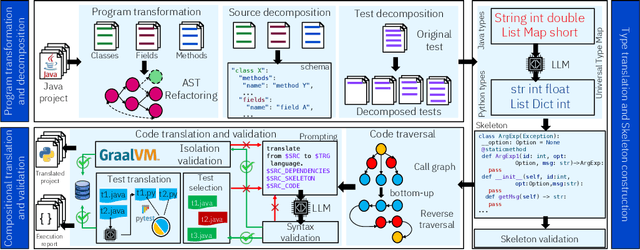Reyhaneh Jabbarvand
MatchFixAgent: Language-Agnostic Autonomous Repository-Level Code Translation Validation and Repair
Sep 19, 2025Abstract:Code translation transforms source code from one programming language (PL) to another. Validating the functional equivalence of translation and repairing, if necessary, are critical steps in code translation. Existing automated validation and repair approaches struggle to generalize to many PLs due to high engineering overhead, and they rely on existing and often inadequate test suites, which results in false claims of equivalence and ineffective translation repair. We develop MatchFixAgent, a large language model (LLM)-based, PL-agnostic framework for equivalence validation and repair of translations. MatchFixAgent features a multi-agent architecture that divides equivalence validation into several sub-tasks to ensure thorough and consistent semantic analysis of the translation. Then it feeds this analysis to test agent to write and execute tests. Upon observing a test failure, the repair agent attempts to fix the translation bug. The final (in)equivalence decision is made by the verdict agent, considering semantic analyses and test execution results. We compare MatchFixAgent's validation and repair results with four repository-level code translation techniques. We use 2,219 translation pairs from their artifacts, which cover 6 PL pairs, and are collected from 24 GitHub projects totaling over 900K lines of code. Our results demonstrate that MatchFixAgent produces (in)equivalence verdicts for 99.2% of translation pairs, with the same equivalence validation result as prior work on 72.8% of them. When MatchFixAgent's result disagrees with prior work, we find that 60.7% of the time MatchFixAgent's result is actually correct. In addition, we show that MatchFixAgent can repair 50.6% of inequivalent translation, compared to prior work's 18.5%. This demonstrates that MatchFixAgent is far more adaptable to many PL pairs than prior work, while producing highly accurate validation results.
Transforming the Hybrid Cloud for Emerging AI Workloads
Nov 20, 2024



Abstract:This white paper, developed through close collaboration between IBM Research and UIUC researchers within the IIDAI Institute, envisions transforming hybrid cloud systems to meet the growing complexity of AI workloads through innovative, full-stack co-design approaches, emphasizing usability, manageability, affordability, adaptability, efficiency, and scalability. By integrating cutting-edge technologies such as generative and agentic AI, cross-layer automation and optimization, unified control plane, and composable and adaptive system architecture, the proposed framework addresses critical challenges in energy efficiency, performance, and cost-effectiveness. Incorporating quantum computing as it matures will enable quantum-accelerated simulations for materials science, climate modeling, and other high-impact domains. Collaborative efforts between academia and industry are central to this vision, driving advancements in foundation models for material design and climate solutions, scalable multimodal data processing, and enhanced physics-based AI emulators for applications like weather forecasting and carbon sequestration. Research priorities include advancing AI agentic systems, LLM as an Abstraction (LLMaaA), AI model optimization and unified abstractions across heterogeneous infrastructure, end-to-end edge-cloud transformation, efficient programming model, middleware and platform, secure infrastructure, application-adaptive cloud systems, and new quantum-classical collaborative workflows. These ideas and solutions encompass both theoretical and practical research questions, requiring coordinated input and support from the research community. This joint initiative aims to establish hybrid clouds as secure, efficient, and sustainable platforms, fostering breakthroughs in AI-driven applications and scientific discovery across academia, industry, and society.
Repository-Level Compositional Code Translation and Validation
Oct 31, 2024



Abstract:Code translation transforms programs from one programming language (PL) to another. Several rule-based transpilers have been designed to automate code translation between different pairs of PLs. However, the rules can become obsolete as the PLs evolve and cannot generalize to other PLs. Recent studies have explored the automation of code translation using Large Language Models (LLMs). One key observation is that such techniques may work well for crafted benchmarks but fail to generalize to the scale and complexity of real-world projects with dependencies, custom types, PL-specific features, etc. We propose AlphaTrans, a neuro-symbolic approach to automate repository-level code translation. AlphaTrans translates both source and test code, and employs multiple levels of validation to ensure the translation preserves the functionality of the source program. To break down the problem for LLMs, AlphaTrans leverages program analysis to decompose the program into fragments and translates them in the reverse call order. We leveraged AlphaTrans to translate ten real-world open-source projects consisting of <836, 8575, 2719> classes, methods, and tests. AlphaTrans translated the entire repository of these projects consisting of 6899 source code fragments. 99.1% of the translated code fragments are syntactically correct, and AlphaTrans validates the translations' runtime behavior and functional correctness for 25.8%. On average, the integrated translation and validation take 36 hours to translate a project, showing its scalability in practice. For the syntactically or semantically incorrect translations, AlphaTrans generates a report including existing translation, stack trace, test errors, or assertion failures. We provided these artifacts to two developers to fix the translation bugs in four projects. They were able to fix the issues in 20.1 hours on average and achieve all passing tests.
CodeMind: A Framework to Challenge Large Language Models for Code Reasoning
Feb 21, 2024Abstract:Solely relying on test passing to evaluate Large Language Models (LLMs) for code synthesis may result in unfair assessment or promoting models with data leakage. As an alternative, we introduce CodeMind, a framework designed to gauge the code reasoning abilities of LLMs. CodeMind currently supports three code reasoning tasks: Independent Execution Reasoning (IER), Dependent Execution Reasoning (DER), and Specification Reasoning (SR). The first two evaluate models to predict the execution output of an arbitrary code or code the model could correctly synthesize. The third one evaluates the extent to which LLMs implement the specified expected behavior. Our extensive evaluation of nine LLMs across five benchmarks in two different programming languages using CodeMind shows that LLMs fairly follow control flow constructs and, in general, explain how inputs evolve to output, specifically for simple programs and the ones they can correctly synthesize. However, their performance drops for code with higher complexity, non-trivial logical and arithmetic operators, non-primitive types, and API calls. Furthermore, we observe that, while correlated, specification reasoning (essential for code synthesis) does not imply execution reasoning (essential for broader programming tasks such as testing and debugging): ranking LLMs based on test passing can be different compared to code reasoning.
White-box Compiler Fuzzing Empowered by Large Language Models
Oct 24, 2023



Abstract:Compiler correctness is crucial, as miscompilation falsifying the program behaviors can lead to serious consequences. In the literature, fuzzing has been extensively studied to uncover compiler defects. However, compiler fuzzing remains challenging: Existing arts focus on black- and grey-box fuzzing, which generates tests without sufficient understanding of internal compiler behaviors. As such, they often fail to construct programs to exercise conditions of intricate optimizations. Meanwhile, traditional white-box techniques are computationally inapplicable to the giant codebase of compilers. Recent advances demonstrate that Large Language Models (LLMs) excel in code generation/understanding tasks and have achieved state-of-the-art performance in black-box fuzzing. Nonetheless, prompting LLMs with compiler source-code information remains a missing piece of research in compiler testing. To this end, we propose WhiteFox, the first white-box compiler fuzzer using LLMs with source-code information to test compiler optimization. WhiteFox adopts a dual-model framework: (i) an analysis LLM examines the low-level optimization source code and produces requirements on the high-level test programs that can trigger the optimization; (ii) a generation LLM produces test programs based on the summarized requirements. Additionally, optimization-triggering tests are used as feedback to further enhance the test generation on the fly. Our evaluation on four popular compilers shows that WhiteFox can generate high-quality tests to exercise deep optimizations requiring intricate conditions, practicing up to 80 more optimizations than state-of-the-art fuzzers. To date, WhiteFox has found in total 96 bugs, with 80 confirmed as previously unknown and 51 already fixed. Beyond compiler testing, WhiteFox can also be adapted for white-box fuzzing of other complex, real-world software systems in general.
Automated Bug Generation in the era of Large Language Models
Oct 03, 2023



Abstract:Bugs are essential in software engineering; many research studies in the past decades have been proposed to detect, localize, and repair bugs in software systems. Effectiveness evaluation of such techniques requires complex bugs, i.e., those that are hard to detect through testing and hard to repair through debugging. From the classic software engineering point of view, a hard-to-repair bug differs from the correct code in multiple locations, making it hard to localize and repair. Hard-to-detect bugs, on the other hand, manifest themselves under specific test inputs and reachability conditions. These two objectives, i.e., generating hard-to-detect and hard-to-repair bugs, are mostly aligned; a bug generation technique can change multiple statements to be covered only under a specific set of inputs. However, these two objectives are conflicting for learning-based techniques: A bug should have a similar code representation to the correct code in the training data to challenge a bug prediction model to distinguish them. The hard-to-repair bug definition remains the same but with a caveat: the more a bug differs from the original code (at multiple locations), the more distant their representations are and easier to be detected. We propose BugFarm, to transform arbitrary code into multiple complex bugs. BugFarm leverages LLMs to mutate code in multiple locations (hard-to-repair). To ensure that multiple modifications do not notably change the code representation, BugFarm analyzes the attention of the underlying model and instructs LLMs to only change the least attended locations (hard-to-detect). Our comprehensive evaluation of 320k+ bugs from over 2.5M mutants generated by BugFarm and two alternative approaches demonstrates our superiority in generating bugs that are hard to detect by learning-based bug prediction approaches and hard to repair by SOTA learning-based program repair technique.
LeTI: Learning to Generate from Textual Interactions
May 17, 2023



Abstract:Finetuning pre-trained language models (LMs) enhances the models' capabilities. Prior techniques fine-tune a pre-trained LM on input-output pairs (e.g., instruction fine-tuning), or with numerical rewards that gauge the quality of its outputs (e.g., reinforcement learning from human feedback). We explore LMs' potential to learn from textual interactions (LeTI) that not only check their correctness with binary labels, but also pinpoint and explain errors in their outputs through textual feedback. Our investigation focuses on the code generation task, where the model produces code pieces in response to natural language instructions. This setting invites a natural and scalable way to acquire the textual feedback: the error messages and stack traces from code execution using a Python interpreter. LeTI iteratively fine-tunes the model, using the LM objective, on a concatenation of natural language instructions, LM-generated programs, and textual feedback, which is only provided when the generated program fails to solve the task. Prepended to this fine-tuning text, a binary reward token is used to differentiate correct and buggy solutions. On MBPP, a code generation dataset, LeTI substantially improves the performance of two base LMs of different scales. LeTI requires no ground-truth outputs for training and even outperforms a fine-tuned baseline that does. LeTI's strong performance generalizes to other datasets. Trained on MBPP, it achieves comparable or better performance than the base LMs on unseen problems in HumanEval. Furthermore, compared to binary feedback, we observe that textual feedback leads to improved generation quality and sample efficiency, achieving the same performance with fewer than half of the gradient steps. LeTI is equally applicable in natural language tasks when they can be formulated as code generation, which we empirically verified on event argument extraction.
Perfect Is the Enemy of Test Oracle
Feb 03, 2023Abstract:Automation of test oracles is one of the most challenging facets of software testing, but remains comparatively less addressed compared to automated test input generation. Test oracles rely on a ground-truth that can distinguish between the correct and buggy behavior to determine whether a test fails (detects a bug) or passes. What makes the oracle problem challenging and undecidable is the assumption that the ground-truth should know the exact expected, correct, or buggy behavior. However, we argue that one can still build an accurate oracle without knowing the exact correct or buggy behavior, but how these two might differ. This paper presents SEER, a learning-based approach that in the absence of test assertions or other types of oracle, can determine whether a unit test passes or fails on a given method under test (MUT). To build the ground-truth, SEER jointly embeds unit tests and the implementation of MUTs into a unified vector space, in such a way that the neural representation of tests are similar to that of MUTs they pass on them, but dissimilar to MUTs they fail on them. The classifier built on top of this vector representation serves as the oracle to generate "fail" labels, when test inputs detect a bug in MUT or "pass" labels, otherwise. Our extensive experiments on applying SEER to more than 5K unit tests from a diverse set of open-source Java projects show that the produced oracle is (1) effective in predicting the fail or pass labels, achieving an overall accuracy, precision, recall, and F1 measure of 93%, 86%, 94%, and 90%, (2) generalizable, predicting the labels for the unit test of projects that were not in training or validation set with negligible performance drop, and (3) efficient, detecting the existence of bugs in only 6.5 milliseconds on average.
 Add to Chrome
Add to Chrome Add to Firefox
Add to Firefox Add to Edge
Add to Edge